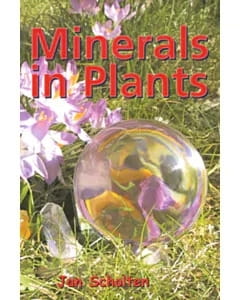Reprinted with the permission of Homeopathic Links, Volume 14, Winter 2001.
In producing his world-famous book on minerals and elements, Jan Scholten must have had many ideas not ripe enough to fit into the structure of that brilliant work.
One of the thoughts that came to his mind was to compare the plant's mineral spectrum with its homeopathic picture.
A study on this theme is now published by Scholten, showing the results of an analysis done some years ago on the mineral contents in plants.
It's an experimental study with only 22 minerals analysed in 100 mostly not well-known plants (like for instance Marrubium, Lespedeza, Eugenia, Carica papaya and Ballota foetida). To be honest, in 150 pages of lists and charts full of test results, you'll find more questions than answers.
But don't worry, the statistics in this book contain some intriguing stuff. some high mineral levels like manganum in the helpful Betula alba and lithium in the extreme Hyoscyamus niger support the materia medica picture. Also remarkable are the highest levels of cuprum, selenium, molybdenum and magnesium all in one plant: Vitis vinifera (Vine tree). Hard for me to understand are the completely different mineral profiles of 'twin plants' like Echinacea aug stifolia/echinacea pur-purea and Tilia alburnum /Tilia cordata. And how about the resemblance between the remedy pictures of Valeriana officinalis and Zincum etallicum, while Valerian appears to have one of the lowest zinc levels of all tested plants?
Questions, questions and more (exciting) questions, not to be answered yet by Jan Scholten who admits he cannot draw too many conclusions as he states: 'This kind of analysis should be repeated often with plants from different regions and climates, from different kinds of soil, with different varieties of plants. More minerals should be analysed with different techniques by different laboratories.'
Reprinted with the permission of The Society of Homeopaths, from 'The Homeopath' Journal, Winter 2002 edition. Reviewed by Fiona Heubeck.
You're familiar with the authors name. You know that kingdoms and classifications are 'in'. You think El2.95 is reasonable. You may even see the cover and think that it looks lovely, accessible, new-agey, inviting. STOP! Don't do it! The author may have dedicated this work "to humanity", but humanity needs to say, "No thanks, we'll have it when it's finished!"
This work, produced in 1993, is not a book. It is not even a rough draft of a book. It is, perhaps, the first jottings of data required to start thinking about drafting a book. I am so amazed by the audacity of anyone producing this as a saleable text that I feel you should see one of the pages:
Caroube
Family:
Scientific name: Caroube
English name:
German name:
French name: Caroube
Dutch name: Johannesbroodboom
Part Used:
Extraction:
Titer: 1/
Standard minimal:
Comment:
Sorted by element name
aluminium 450,8 6,4
arsenicum 0,0 -0,4
cadmium 0,0 -0,3
calcium 3502,0 O,l
chromium 1,9 3,5
cobalt I,l 2,0
Sorted by relative difference
iron 11 78,0 7,6
aluminium 450,8 6,4
chromium 1,9 3,5
vanadium 2,8 3,4
cobalt 1,1 2,0
mercury 0,7 1,0
( + 18 more minerals listed - otherwise this is exactly as it appears.)
"Oh, that's not fair," you retort, "there must be more to it than that - one page taken out of context tells us nothing!" Well, sorry, but it is fair - there is no more to it, no context is provided, and all the pages look just like that. (Except for the converse classifications, where the mineral heads the page and all the plants containing it are listed alphabetically.) Let's not even mention the translation mistakes and missing words. Suffice it to say this is not a book useful for homeopathic purposes. it looks very much like an unwanted collection of computerised lists left over from other research - perhaps preliminary jottings from the preparations for Homeopathy and Minerals? (A real book, also produced in 1993.) If you're interested in discovering which plants absorb which minerals for therapeutic uses, a more holistic approach would be to investigate anthroposophical medicine. Or you could always try prescribing on the presenting symptoms using a repertory. What do you think - too radical?

